Canary Wharf
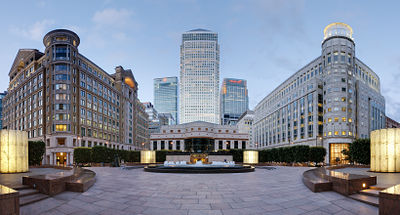
Canary Wharf is a major business district in the London Borough of Tower Hamlets, England. Rivalling London's traditional financial centre, the City of London, Canary Wharf contains many of the United Kingdom's premier office spaces and tallest buildings.[1]
Contents |
History
Canary Wharf is built on the site of the West India Docks on the Isle of Dogs. From 1802, the area was one of the busiest docks in the world. By the 1950s, the port industry began to decline, leading to the docks closing by 1980.[2]
Canary Wharf itself takes its name from No. 32 berth of the West Wood Quay of the Import Dock. This was built in 1936 for Fruit Lines Ltd, a subsidiary of Fred Olsen Lines for the Mediterranean and Canary Island (Insula Canaria (from canis) "Island of Dogs") fruit trade. At their request, the quay and warehouse were given the name Canary Wharf.[3]
The Canary Wharf of today began when Michael von Clemm, former chairman of Credit Suisse First Boston (CSFB), came up with the idea to convert Canary Wharf into back office. Further discussions with G Ware Travelstead led to proposals for a new business district. The project was sold to Olympia & York[4] and construction began in 1988. The first buildings were completed in 1991 which included One Canada Square that became the UK's tallest building and a powerful symbol of the regeneration of Docklands. Upon opening, the London commercial property market had collapsed and Olympia and York Canary Wharf Limited filed for bankruptcy in May 1992.
Local opposition
The idea of a new financial services district was not popular with local residents as the expectation was that the development would provide no local jobs or transport improvements. However, over the course of the development relations with the local community have improved and more than 7,000 local (Tower Hamlets) residents work at Canary Wharf.
In 1997, some residents living on the Isle of Dogs launched a lawsuit against Canary Wharf Ltd for private nuisance because the tower caused interference with television signals. The residents lost the case.[5]
Rescue and recovery
In December 1995 an international consortium, backed by the former owners of Olympia & York and other investors, bought the scheme. The new company was called Canary Wharf Limited, and later became Canary Wharf Group.
Recovery in the property market generally, coupled with continuing demand for high floor-plate grade A office accommodation, slowly improved the level of interest in the estate. A critical event in the recovery of Canary Wharf was the much-delayed start of work on the Jubilee Line, which the government wanted ready for the Millennium celebrations.
In March 2004 Canary Wharf Group plc was forced to be taken over by a consortium of investors led by Morgan Stanley using a vehicle named Songbird Estates.
Present day
Canary Wharf tenants include major banks, such as Barclays, Credit Suisse, HSBC and Citigroup, law firms such as Clifford Chance and Allen & Overy, Advertising agencies such as Ogilvy & Mather, as well as news media and service firms, including Thomson Reuters, and Trinity Mirror.
Over 100,000 people are employed on the estate, around 25% of whom live in the surrounding five boroughs. With the opening of Jubilee Place shopping centre, Canary Wharf has become a shopping destination.
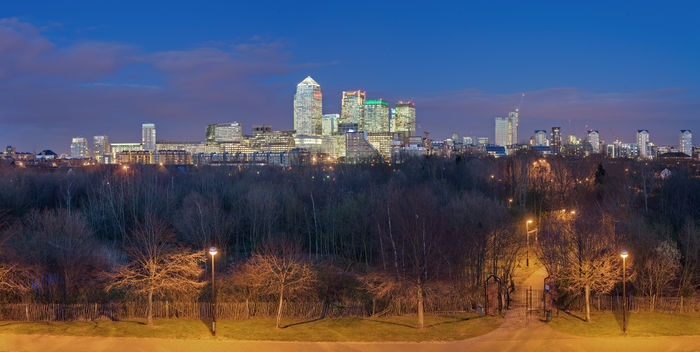
Tallest buildings
Completed buildings
| Rank | Image | Name | Height | Floors | year | Notes | |
|---|---|---|---|---|---|---|---|
| Metres | feet | ||||||
| 1 |  |
One Canada Square | 235 | 771 | 50 | 1991 | This is the 14th-tallest building in Europe, and currently the tallest building in the United Kingdom. Tallest building in the United Kingdom since 1991. Tallest structure completed in London in the 1990s. |
| 2= |  |
8 Canada Square | 200 | 655 | 42 | 2002 | The 22nd-tallest building in Europe, second-tallest building in the United Kingdom. Also known as the HSBC HQ. |
| 2= |  |
25 Canada Square | 200 | 655 | 42 | 2001 | The 22nd-tallest building in Europe, second-tallest building in the United Kingdom. Also known as the Citigroup Centre, London. |
| 3 | 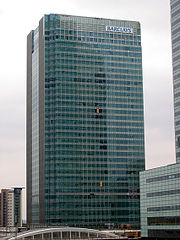 |
One Churchill Place | 156 | 513 | 32 | 2005 | Seventh-tallest building in the United Kingdom. The building was originally planned to be 50 stories in height, but was scaled down to 31 after the 9/11 terrorist attacks and this would have been the tallest building in Canary Wharf. |
| 4= |  |
40 Bank Street | 153 | 502 | 33 | 2003 | Eighth-tallest building in the United Kingdom. |
| 4= |  |
25 Bank Street | 153 | 502 | 33 | 2003 | Eighth-tallest building in the United Kingdom. |
| 5 |  |
10 Upper Bank Street | 151 | 495 | 32 | 2003 | Tenth-tallest building in the United Kingdom. |
| 6 |  |
Pan Peninsula | 147 | 484 | 48 | 2008 | Sixth-tallest building in Canary Wharf. |
| 7 | 33 Canada Square | 105 | 344 | 18 | 1999 | ||
| 8 | 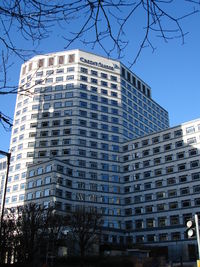 |
1 Cabot Square | 89 | 292 | 21 | 1991 | 1 Cabot Square also known as Credit Suisse. |
| 9 |  |
5 Canada Square | 88 | 288 | 16 | 2003 | The principal tenant at 5 Canada Square is the European arm and HQ of Banc of America Securities, and features one of Europe's largest trading floors.Credit Suisse has one half of the building but only occupies floors 11-15. |
| 10 |  |
25 Cabot Square | 81 | 265 | 17 | 1991 | The architect on the project was Skidmore Owings & Merrill. |
| 11 |  |
25 North Colonnade | 80 | 262 | 17 | 1991 | |
| 12 |  |
20 Bank Street | 68 | 223 | 14 | 2003 | 20 Bank Street (Heron Quays 1 (HQ1) or the Morgan Stanley Building). The building was designed by Skidmore, Owings & Merrill (SOM). |
| 13 | 50 Bank Street | 63 | 206 | 11 | 2002 | ||
Under-construction buildings
| Name | Height | Floors | year | Status | Notes | |
|---|---|---|---|---|---|---|
| metres | feet | |||||
| Riverside South, Tower 1 | 236 | 774 | 45 | 2012 | Under Construction | Due to become Canary Wharf's second tallest building upon completion. |
| Riverside South, Tower 2 | 189 | 610 | 38 | 2012 | Under Construction | |
Approved buildings
| Name | Height | Floors | year | Status | Notes | |
|---|---|---|---|---|---|---|
| metres | feet | |||||
| Columbus Tower | 237 | 778 | 63 | 2012 | Approved | Originally refused in 2008 by the London Borough of Tower Hamlets, but London's Mayor Boris Johnson overruled the decision and approved the building. Due to become Canary Wharf's tallest building upon completion. Construction is delayed due to the Crossrail construction. |
| North Quay, Tower 1 | 221 | 727 | 44 | 2017 | Approved | |
| Heron Quays West | 214 | 702 | 40 | 2017 | Approved | |
| Wood Wharf W07B | 206 | 676 | 51 | 2019 | Approved | |
| North Quay, Tower 3 | 209 | 667 | 38 | 2017 | Approved | |
| Wood Wharf W06 | 187 | 618 | 45 | 2019 | Approved | |
| Wood Wharf W02 | 182 | 598 | 40+ | 2019 | Approved | |
| Wood Wharf W07A | 128 | 418 | 30+ | 2019 | Approved | |
| North Quay, Tower 2 | 120 | 393 | 18 | 2017 | Approved | |
Timeline of tallest buildings
| Name | Image | Height | Floors | Years as tallest |
| 1 Cabot Square |  |
89 | 21 | earl 1991 - late 1991 |
| One Canada Square |  |
235 | 50 | late 1991 - |
 Canary Wharf 2005 night view |
 Canary Wharf 2007 night view |
The A1261 road which had just came of the A13 road heading towards Canary Wharf |
 A street view of One Churchill Place |
 Canary Wharf in year 2000 with One Canada Square with 8 Canada Square & 25 Canada Square still under construction |
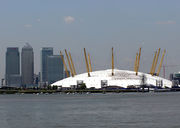 The O2 Arena & Canary Wharf in the background |
 Canary Wharf from Cabot Square |
 A street view of 25 Bank Street |
Transportation
Docklands Light Railway
Heron Quays
One of the first stations to be built in Canary Wharf. The station first opened up in 1987. The station has two platforms in use, is in Travelcard Zone 2, and is on the Lewisham branch of the Docklands Light Railway, between Canary Wharf and South Quay. The station was moved 200 metres south (to fit inside the new buildings) and a longer platform was built at this new site to accommodate three-unit trains planned as part of the DLR Capacity Enhancement; the station re-opened on 18 December 2002.
South Quay
The original South Quay station opened in 1987, and was a standard DLR phase 1 elevated station, subsequently extended to permit the use of 2 car trains.
In 1996, near the station, the Docklands bombing killed 2 people and injured over 30 & than rebuilt the station.
Canary Wharf
Canary Wharf station had been part of the original DLR plans, but when the system opened in August 1987 the station was not ready. It was originally planned that the station would be similar to the original station at Heron Quays, with two small platforms either side of the tracks.The station is located on the DLR between Heron Quays station and the West India Quay station, in Travelcard Zone 2, which are in fact the three closest train stations on the same line in the world.
London Underground
The Canary Wharf tube station is a two platform station which opened in 1999 on the Jubilee Line's extension from Charing Cross to Stratford. Canary Wharf station has increasingly become one of the busiest stations on the network, serving the ever-expanding Canary Wharf business district. The station was used as a location for some scenes of Danny Boyle's 2002 film 28 Days Later and its sequel 28 weeks later which was mostly based in Canary Wharf.
National Rail
Canary Wharf railway station began construction in May 2009 and will be completed in 2017. The station will have two platforms and will be in the Travelcard Zone 2.
Aviation
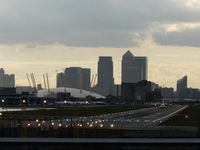
London City Airport is linked to London's new financial district at Canary Wharf and to the traditional financial district of the City of London via the Docklands Light Railway, and with an interchange to the London Underground. London City Airport DLR station is situated immediately adjacent to the terminal building, with enclosed access to and from the elevated platforms.
Bus Routes
135
This bus route starts at Old Street Station & ends at Crossharbour. The operator for this bus is Arriva London.
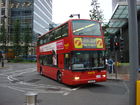
277
This bus route starts at Highbury & Islington and ends at Leamouth, the via stops are Dalston, Hackney Central, Mile End & Canary Wharf. The frequency of this bus is about every 7–30 minutes.
N550
This is a night bus route that travels 11 miles & runs about every 30 minutes. This bus route starts at Canning Town & ends at Trafalgar Square.
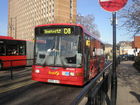
Local buses
These are local buses that goes mostly around the London Docklands area. Note: These buses mostly start/end at a Docklands Light Railway Station.
D3
D6
D7
D8
London River Services
The Canary Wharf Pier is a London River Services pier on the River Thames in London, UK. It is located to the west of the Canary Wharf district, close to Narrow Street, Limehouse.
Significance and impact
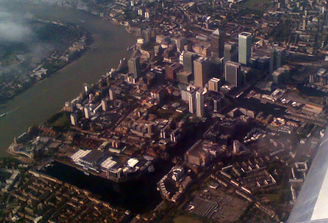
The most immediate impact of Canary Wharf has been to substantially increase land values in the surrounding area. This means that the Isle of Dogs, which had previously been seen as suited for low-density light industrial development, has been up-rated. Projects such as South Quay Plaza and West India Quay are a direct consequence of this. At the peak of property prices in 2007, the HSBC building sold for a record £1.1 billion.[6]
At the metropolitan level, Canary Wharf was, and remains, a direct challenge to the primacy of the City of London as the UK's principal centre for the finance industry. Relations between Canary Wharf and the City of London Corporation have frequently been strained, with the City accusing Canary Wharf of poaching tenants, and Canary Wharf accusing the City of not catering to occupier needs.
Canary Wharf's national significance comes from what it replaces: the former docks were, as recently as 1961, the busiest in the world. They served huge industrial areas of east London and beyond. Both the docks and much of that industrial capacity are gone, with employment shifting to the service industry accommodated in office buildings. In this respect, Canary Wharf could be cited as the strongest single symbol of the changed economic geography of the United Kingdom.
The Radiohead song "Fake Plastic Trees" is about Canary Wharf[7]. In addition, the Doctor Who episodes "Doomsday" and "Army of Ghosts" both take place within Canary Wharf. The Battle of Canary Wharf is continually mentioned throughout the rest of the series, as well as in the spin-off show Torchwood.
References and notes
- ↑ "United Kingdom list of tallest buildings". SkyscraperPage.com. http://skyscraperpage.com/cities/?countryID=133. Retrieved 2009-01-12.
- ↑ West India Docks (1803-1980) (Port Cities) accessed 22 July 2008
- ↑ The West India Docks: The buildings: warehouses, Survey of London: volumes 43 and 44: Poplar, Blackwall and Isle of Dogs (1994), pp. 284-300. Retrieved 22 July 2008
- ↑ "The Development of Transport in London Docklands - Part I: The Chronological Story". LDDC history. 1987-07-17. http://www.lddc-history.org.uk/transport/tranmon2.html#Era. Retrieved 2009-01-12.
- ↑ The court found against the appellants (Hunter and others) as private nuisance legislation generally concerns 'emanations' from land, not interference with such emanations. "Hunter and Others v. Canary Wharf Ltd./Hunter and Others v. London Docklands Corporation" House of Lords Session 1996-97. Retrieved on 2009-03-23.
- ↑ Saunders, Craig (2007-06-19). "Canary Wharf singing a red-hot tune". The Globe and Mail. http://www.theglobeandmail.com/servlet/story/LAC.20070619.PRLONDON19/TPStory/Business. Retrieved 2009-01-12.
- ↑ http://www.youtube.com/watch?v=MsMmJjWe0hM
See also
- The Canary Wharf of the North
- Canary Wharfs tube station
- Canary Wharf DLR station (Docklands Light Railway station)
- Heron Quays DLR station
- South Quay DLR station
- Canary Wharf railway station (under construction)
- Canary Wharf – Rotherhithe Ferry
- Canary Wharf, London City Airport
External links
|
||||||||||||||